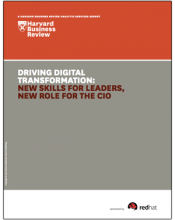When faced with a business challenge, business leaders often have a good idea where they need to go and how they must evolve. But there is often a mismatch in how prepared they perceive their organization to be, and the cold, hard reality within their walls. This is especially true when it comes to the challenges associated with the way digital technology is reshaping our future.

It doesn't matter how clear your objectives are or how obvious the initiative may seem to you and your leadership team. The fact is, change takes time. There will always be stakeholders who are resistant to change, and they can slow, or in some cases, even stall the pace of evolution for the entire enterprise. You may have all the necessary systems in place for change, but if your people are not exploiting them, your organization will remain stuck in its legacy ways.
In the case of digital transformation, there is often no room for error. A mismatch in perception and reality could mean the difference between your business surviving or failing in the digital future. At a recent event, I was reminded that the average tenure of Fortune 500 companies is falling dramatically as companies that are “born digital” continue to surpass their old-school counterparts. Becoming digital is no longer an option – it's a survival issue.
Past successes may make little difference. You could be, for example, a superior manufacturer of automotive technology, but you will become a niche player unless you can determine how to adapt to all of the various technology and information capabilities that are becoming increasingly important in the automotive industry. And that’s just one example. Ask former book sellers or music retailers how fast change can occur.
The world *is* changing
Bottom line, the world is changing, and you and your enterprise must change as well.
So how do you close the gap between perception and reality? Seek out those within your organization who are most resistant to change, and educate and empower them to share your vision for digital transformation.
We are seeing a good example of this as it relates to the waning CMO-CIO-CDO “conflict.” The Internet and mobile technology have had a vast impact on marketing. That led to some early conflict among CIOs, CMOs, and the creation of some CDO positions. The world has since evolved. As a result, we’re beginning to see a much more united effort on the part of forward thinking organizations, where marketing and IT are not only aligned, but they are also collaborating and increasingly share accountability for digital initiatives.
IT must now go a step further and provide a similar level of coaching, facilitation, and services to all areas of the enterprise. For example, help your HR team improve its use of social and Internet tools to identify and attract a pipeline of candidates. Ensure that the right information dissemination and collaboration tools are in place to help retain associates. Assist sales in using digital tools to identify prospects, make customized presentations, and ensure that they’re fully leveraging solutions for your customers. Help customer service provide even better digital tools to keep your customers happy.
From legal to manufacturing, supply chain and procurement – digital technology is rapidly changing and could be greatly improving all areas of your enterprise. Digital trends are too vital to ignore. In fact, ignoring the trends will lead your enterprise to irrelevance.
ALSO READ
Lee Congdon is responsible for Red Hat’s global information systems, including the technology strategy, enterprise architecture, information technology governance, solutions delivery, and systems operations supporting the company. His role includes enabling Red Hat’s business through services, such as knowledge management, technology innovation, technology-enabled collaboration, and process improvement. Congdon has more than 25 years of experience as an IT leader. Prior to joining Red Hat® he was managing vice president, Information Technology, at Capital One where he developed and delivered IT solutions for the firm’s corporate functions and Global Financial Services group.




